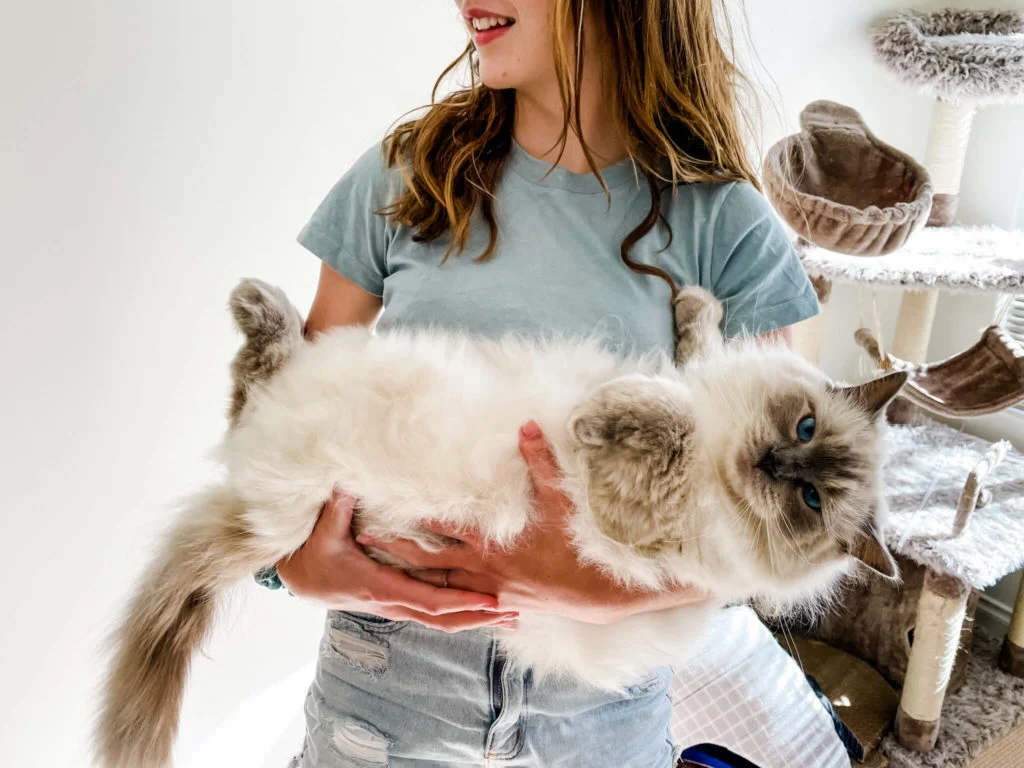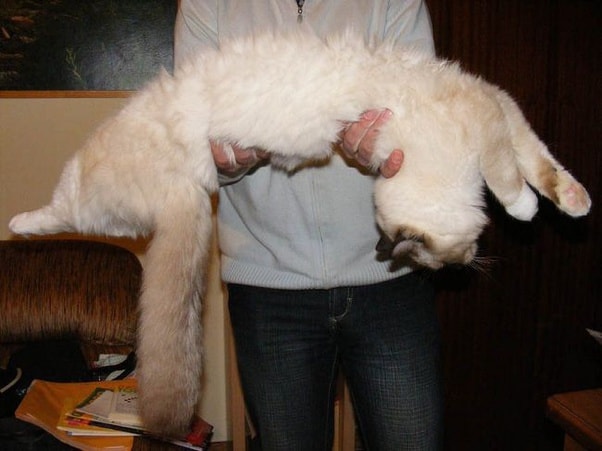Ragdoll cats are known for their beautiful appearance and gentle nature. However, one behavior that can be a cause for concern among pet owners is limping. Why do Ragdoll cats go limp?
tl;dr: Ragdoll cats go limp and relaxed when picked up or held due to a genetic trait that causes them to have a naturally relaxed and passive temperament, making them go “limp” in response to handling or touch. In addition, injury and health issues are also the common causes.
When a Ragdoll cat starts limping, it can be a sign of an underlying health issue or injury. Understanding the causes and signs of limping in Ragdoll cats is crucial for pet owners to ensure the well-being of their beloved feline companions.
What is a Ragdoll Cat? A Brief Overview of the Breed
Ragdoll cats are a relatively new breed that originated in California in the 1960s. They were created by a breeder named Ann Baker, who crossed a white Persian cat with a Birman cat and a Burmese cat. The result was a breed with striking blue eyes, semi-long hair, and a docile temperament.
Ragdolls are known for their large size, with males weighing between 15-20 pounds and females weighing between 10-15 pounds. They have a muscular build and a soft, silky coat that comes in various colors and patterns, including seal, blue, chocolate, lilac, and cream.
In terms of temperament, Ragdolls are often described as gentle, affectionate, and sociable cats. They are known for their tendency to go limp when picked up or held, hence the name “Ragdoll.” They are also known to be good with children and other pets, making them an ideal choice for families.
The Importance of Understanding Your Ragdoll Cat’s Behavior
Understanding your Ragdoll cat’s behavior is essential for several reasons. Firstly, it allows you to build a strong bond with your pet and provide them with the care they need. By understanding their behavior patterns and preferences, you can create an environment that is conducive to their well-being.
Secondly, behavior can be an indicator of underlying health issues. Cats are masters at hiding pain and discomfort, so changes in behavior can often be the first sign that something is wrong. By paying attention to your Ragdoll cat’s behavior, you can catch potential health problems early and seek appropriate medical attention.
Common Causes of Limping in Ragdoll Cats: Injury or Health Issues?
Limping in Ragdoll cats can be caused by a variety of factors, including injuries and health issues. Some common causes of limping include:
1. Injuries: Ragdoll cats are active and playful animals, which puts them at risk for injuries such as sprains, strains, fractures, and dislocations. These injuries can occur from jumping off high surfaces, rough play with other pets, or accidents around the house.
2. Arthritis: Like humans, cats can develop arthritis as they age. Arthritis is a degenerative joint disease that causes inflammation and pain in the joints. This can lead to limping and difficulty moving around.
3. Infections: Infections, such as abscesses or cellulitis, can cause swelling and pain in the affected area, leading to limping.
4. Muscle or ligament tears: Tears in the muscles or ligaments can occur from sudden movements or trauma. These tears can cause pain and limping.
It is important to note that these are just a few examples of the common causes of limping in Ragdoll cats. If your cat is limping, it is best to consult with a veterinarian to determine the underlying cause and appropriate treatment.
How to Identify Limping in Ragdoll Cats: Signs and Symptoms
Identifying limping behavior in Ragdoll cats requires careful observation and attention to detail. Some signs and symptoms to look out for include:
1. Limping or favoring one leg: Observe your cat’s gait and look for any signs of limping or favoring one leg over the others. This can be seen as a noticeable limp or a slight change in the way your cat walks.
2. Reluctance to jump or climb: If your Ragdoll cat is usually active and suddenly becomes hesitant to jump or climb, it may be a sign that they are experiencing pain or discomfort.
3. Swelling or redness: Check your cat’s legs and paws for any signs of swelling, redness, or heat. These can be indicators of inflammation or injury.
4. Vocalization or aggression: Cats in pain may vocalize more than usual or exhibit aggressive behavior when touched or approached. If your normally docile Ragdoll cat becomes aggressive when you try to examine their leg, it may be a sign that they are in pain.
It is important to note that these signs and symptoms can vary depending on the underlying cause of the limping. If you notice any changes in your Ragdoll cat’s behavior or mobility, it is best to consult with a veterinarian for a proper diagnosis.
Steps to Take if Your Ragdoll Cat is Limping: First Aid and Medical Attention
If you notice that your Ragdoll cat is limping, there are several steps you can take to provide immediate first aid and ensure their well-being:
1. Assess the situation: Carefully examine your cat’s leg for any visible signs of injury, such as cuts, swelling, or bleeding. If you suspect a fracture or dislocation, do not attempt to manipulate the limb yourself as this can cause further damage.
2. Provide a comfortable resting area: Create a quiet and comfortable space for your cat to rest and recover. Make sure they have access to food, water, and a litter box nearby.
3. Limit their activity: Restrict your cat’s movement to prevent further injury. Encourage them to rest and avoid jumping or climbing.
4. Apply cold compress: If there is swelling or inflammation, you can apply a cold compress to the affected area for 10-15 minutes at a time. This can help reduce pain and swelling.
5. Consult with a veterinarian: It is important to seek medical attention for your Ragdoll cat if they are limping. A veterinarian will be able to properly diagnose the underlying cause of the limping and provide appropriate treatment.
Preventing Limping in Ragdoll Cats: Tips for a Safe and Healthy Environment
Preventing limping in Ragdoll cats involves creating a safe and healthy environment for them to thrive. Here are some tips to help prevent injuries and promote overall well-being:
1. Provide appropriate toys and scratching posts: Ragdoll cats are active and playful, so it is important to provide them with toys and scratching posts that are suitable for their size and energy levels. This will help prevent them from engaging in rough play or climbing on furniture that may lead to injuries.
2. Keep hazardous objects out of reach: Ensure that your home is free from hazardous objects that could cause injury to your cat, such as sharp objects, toxic plants, or small items that can be swallowed.
3. Regular veterinary check-ups: Schedule regular check-ups with your veterinarian to monitor your Ragdoll cat’s health and catch any potential issues early on.
4. Maintain a healthy weight: Obesity can put extra strain on your cat’s joints and increase the risk of injuries. Ensure that your Ragdoll cat maintains a healthy weight through a balanced diet and regular exercise.
5. Provide a safe outdoor environment: If you allow your Ragdoll cat outdoors, make sure they have access to a safe and secure outdoor space. This can help prevent accidents or encounters with other animals that may lead to injuries.
The Role of Genetics in Limping Behavior in Ragdoll Cats
Genetics can play a role in limping behavior in Ragdoll cats. Some genetic conditions, such as hip dysplasia or luxating patella, can predispose cats to limping or mobility issues. These conditions are inherited and can be present from birth or develop later in life.
It is important for Ragdoll cat breeders to screen their breeding cats for genetic conditions to reduce the risk of passing them on to future generations. Responsible breeders will conduct health tests and only breed cats that are free from genetic conditions.
If you are considering getting a Ragdoll cat, it is important to choose a reputable breeder who prioritizes the health and well-being of their cats. Ask the breeder about any health tests they conduct and request documentation to ensure that you are getting a healthy kitten.
Understanding Your Ragdoll Cat’s Personality: How it Affects Their Limping Behavior
A Ragdoll cat’s personality can have an impact on their limping behavior. Some cats may be more prone to injuries due to their adventurous and fearless nature, while others may be more cautious and less likely to engage in activities that could lead to injuries.
Additionally, a cat’s personality can affect how they respond to pain or discomfort. Some cats may be more vocal or aggressive when they are in pain, while others may try to hide their discomfort. Understanding your Ragdoll cat’s personality can help you better assess their behavior and determine if they are experiencing any pain or discomfort.
Conclusion: Caring for Your Ragdoll Cat’s Unique Needs and Behaviors
Caring for a Ragdoll cat involves understanding their unique needs and behaviors. Limping behavior can be a cause for concern among pet owners, as it can indicate underlying health issues or injuries. By understanding the common causes and signs of limping in Ragdoll cats, pet owners can provide appropriate care and seek medical attention when necessary.
Creating a safe and healthy environment for your Ragdoll cat is crucial in preventing injuries and promoting overall well-being. Regular veterinary check-ups, a balanced diet, and appropriate exercise are essential for maintaining your cat’s health. Additionally, understanding your Ragdoll cat’s personality can help you better assess their behavior and provide the care they need.
By being attentive to your Ragdoll cat’s behavior and needs, you can ensure that they live a happy and healthy life. Remember to consult with a veterinarian if you have any concerns about your cat’s limping behavior or overall well-being.
Originally posted 2023-06-04 02:34:32.
Johny is a dedicated pet enthusiast, author, and the driving force behind the insightful content at PetSWAT. With a deep passion for animals and a wealth of knowledge acquired through years of experience, Johny brings a unique perspective to the world of pet care and companionship.



